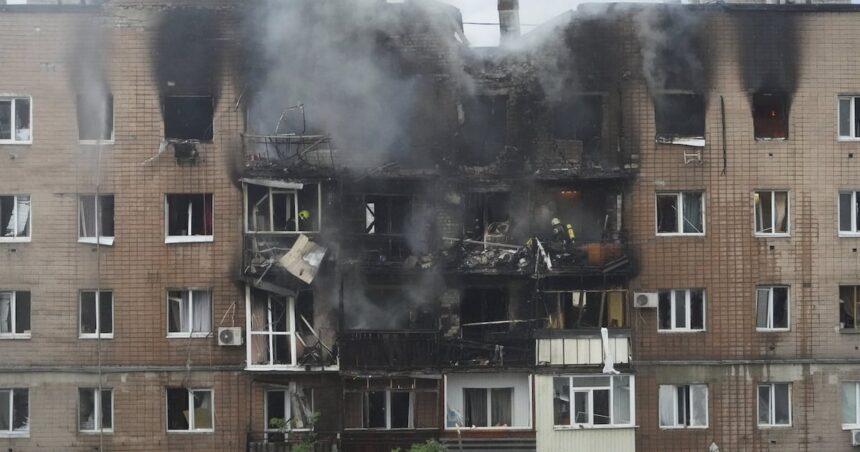As dawn broke over Kyiv yesterday, I watched Ukraine’s air defense systems light up the pre-morning sky in what officials later confirmed was the most massive drone assault since Russia’s full-scale invasion began. The irony wasn’t lost on anyone here – this unprecedented aerial bombardment came just as diplomatic channels were supposedly opening for potential peace discussions.
“We haven’t seen anything like this before,” said Colonel Yuriy Ihnat, who I spoke with at the Ukrainian Air Force command center. “The Russians launched 188 Shahed drones in a single night. Our teams were working continuously for over six hours.”
Ukrainian air defenses managed to intercept 144 of the Iranian-made drones, but the sheer volume overwhelmed even their sophisticated countermeasures. The remaining drones struck energy infrastructure across multiple regions, plunging thousands into darkness amid dropping winter temperatures.
In Odesa, I toured the damage with local officials. A direct hit on a power substation left three districts without electricity. Engineers worked frantically in the bitter cold, their breath visible as they assessed twisted metal and charred equipment.
“This is a deliberate attempt to break Ukrainian society before winter fully arrives,” explained energy minister Herman Halushchenko during our interview. “Russia knows exactly what they’re targeting and when it will cause maximum civilian impact.”
The timing couldn’t be more calculated. This assault coincides with Ukrainian President Volodymyr Zelenskyy’s recent peace initiative presentation at a summit in Switzerland, which outlined his vision for ending the conflict. The Kremlin has dismissed the proposal as “detached from reality” while demonstrating its own brutal alternative.
Military analysts I’ve consulted point to Russia’s concerning production capacity. “What we’re seeing indicates Russia has significantly expanded its domestic drone manufacturing,” said Mykola Bielieskov from the Ukrainian Institute for Strategic Studies. “They’re now producing enough Shaheds to launch these massive attacks without depleting their stockpiles.”
Financial data supports this assessment. Recent economic intelligence from Western sources indicates Moscow has allocated an additional $1.2 billion to drone production facilities, with new manufacturing centers established in Tatarstan and Alabuga.
On the ground, the human cost is immediate. In Zhytomyr region, emergency crews pulled an elderly couple from the rubble of their home, destroyed when drone debris crashed through their roof after an interception. The husband, 78-year-old Petro Kovalenko, died en route to the hospital.
“He survived the Soviet era, Ukrainian independence, and almost three years of this war,” his neighbor Svitlana told me, wiping tears from her weathered face. “And now this.”
The strategic calculus behind such massive drone deployments is multifaceted. Beyond the physical damage, these attacks force Ukraine to expend precious air defense missiles. Each Patriot or NASAMS interceptor costs substantially more than the relatively cheap Shahed drones they’re targeting.
“It’s economic warfare,” explained retired General Viktor Muzhenko, former Chief of the General Staff, when I called him for analysis. “Russia spends approximately $50,000 per Shahed, while some Western interceptor missiles cost twenty times that amount. The math is deliberately punishing.”
Diplomatically, the assault sends an unambiguous message about Russia’s willingness to negotiate. Just hours before the drones launched, Russian Foreign Minister Sergei Lavrov had stated Moscow remained “open to dialogue” – a claim that rings hollow amid the destruction I’ve witnessed.
The UN Security Council convened an emergency session following the attacks. U.S. Ambassador Linda Thomas-Greenfield condemned what she called “Russia’s continued weaponization of winter,” while Russian representatives claimed without evidence that the facilities targeted were military-industrial complexes.
Meanwhile, in Brussels, NATO officials expressed concern about depleting air defense resources. “We’re working with allies to accelerate additional air defense capabilities for Ukraine,” NATO Secretary General Mark Rutte told reporters. European defense contractors have pledged to ramp up production, but industry experts warn that manufacturing bottlenecks will take months to resolve.
For ordinary Ukrainians, the immediate future looks grimly familiar. Power companies have already announced rolling blackouts in five regions. Hospitals are relying on generators, and subway stations in major cities are again being prepared as warming centers.
Back in Kyiv, as emergency crews cleared debris from a damaged power station, I spoke with Oleksandr, a 54-year-old electrical engineer working overtime to restore power.
“They want us to freeze in the dark, to surrender,” he said, not looking up from the circuit panel he was repairing. “But we’ve been through this before. We’ll fix it, patch it, keep it running. What choice do we have?”
His resilience echoes throughout the country, even as the technical challenges mount. Ukraine’s energy grid has endured nearly three years of targeted attacks, leaving it increasingly vulnerable with each new assault.
As international attention shifts between various global flashpoints, Ukrainians fear becoming yesterday’s crisis. But the reality I’ve witnessed on the ground remains urgent and unresolved. While diplomatic language around “peace initiatives” and “negotiation frameworks” fills international headlines, the thunderous reality of drone explosions and the quiet suffering of civilians without heat or power tells a different story.
The question now facing Ukraine’s allies is whether this record-breaking attack will prompt a corresponding record in support – or whether such escalations are becoming the accepted background noise of a conflict entering its third winter.






